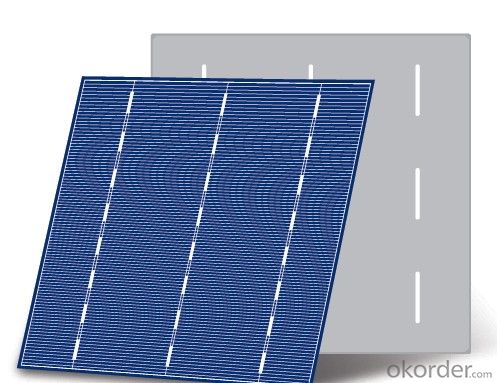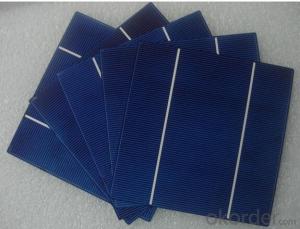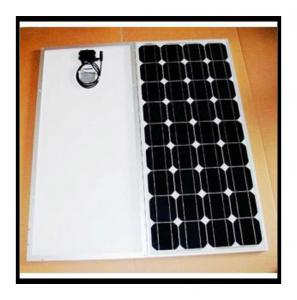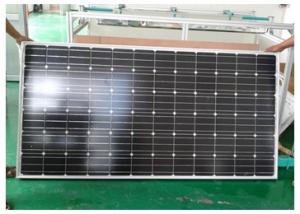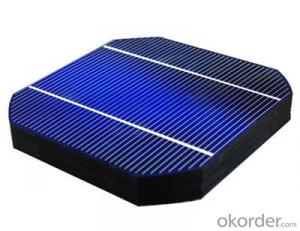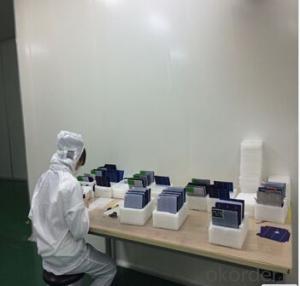Spinach Solar Cells Mono 125x125mm
- Loading Port:
- China Main Port
- Payment Terms:
- TT OR LC
- Min Order Qty:
- -
- Supply Capability:
- -
OKorder Service Pledge
OKorder Financial Service
You Might Also Like
Introduction:
We supply regular mono 125x125mm and poly 156x156mm solar cells.
Cells made in China mainland and Taiwan are both available.
Cell production capacity yearly reach 1GW.
Our cells pattern include continuous and uncontinuous busbar to meet different cells line.
PART2: Special features:
1. High conversion efficiencies resulting in superior power output performance
2.Outstanding power output even in low light or high temperature conditions
3.Optimized design for ease of soldering and lamination
4.Long-term stability,reliability and performance
5.For 156P poly cells with high efficiency in photovoltaic conversion 16.3%-17.5%.
6.Low inverse current, high shunt resistance and high dependability.
- Q: How do solar cells generate electricity?
- Solar cells generate electricity through the photovoltaic effect, where sunlight photons excite electrons in the cell's semiconductor material, creating a flow of electric current.
- Q: Where and how can I find more information of Photovoltaic Cells Solar Panels? Can anybody share more about that?
- Photovoltaic cells are considered to be one of the most reliable sun power generation materials and very easy to to maintain.
- Q: Can solar cells be used to power parking meters?
- Yes, solar cells can be used to power parking meters. Solar cells convert sunlight into electricity, making them a sustainable and environmentally friendly power source for various applications, including parking meters. By harnessing solar energy, parking meters can operate independently, reducing the need for frequent battery replacements or connection to the electrical grid.
- Q: Can solar cells be installed on sloped surfaces?
- Yes, solar cells can be installed on sloped surfaces. In fact, sloped surfaces can often be advantageous for solar panel installation as they allow for better sun exposure and increased energy generation.
- Q: What is the impact of solar cells on job creation?
- Solar cells have had a significant positive impact on job creation. The rapid growth of the solar industry has created numerous job opportunities across various sectors, including manufacturing, installation, and maintenance. This has not only boosted employment rates but also led to the development of specialized skills and the creation of new businesses. Moreover, the shift towards renewable energy sources like solar power has the potential to further drive job creation as the demand for clean energy continues to increase.
- Q: Can solar cells be used in security systems?
- Yes, solar cells can be used in security systems. Solar-powered security systems utilize solar cells to convert sunlight into electricity, which is then stored in batteries for continuous power supply. This allows security systems to operate independently of the electrical grid, making them more reliable and cost-effective in remote or off-grid locations. Additionally, solar-powered security systems are environmentally friendly, reducing dependence on fossil fuels and lowering carbon emissions.
- Q: What is the current situation and the recent progress space solar cells in China?
- The space solar cells is uniquely designed for the power supply for the space, which is very expensive to build and maintain.
- Q: Can solar cells be used in indoor applications?
- Yes, solar cells can be used in indoor applications. While they are typically designed for outdoor use to harness sunlight, indoor solar cells can still generate electricity from artificial light sources such as fluorescent or LED lights. However, the efficiency of indoor solar cells is generally lower compared to outdoor usage due to the lower intensity and variability of indoor lighting.
- Q: What is the impact of dust or dirt on solar cell performance?
- The presence of dust or dirt on solar cells can significantly impact their performance. As these particles accumulate on the surface of the cells, they create a barrier that reduces the amount of sunlight reaching the photovoltaic material. This obstruction leads to a decrease in the conversion of solar energy into electricity, resulting in a lower overall efficiency of the solar panels. Regular cleaning and maintenance are essential to ensure optimal performance and maximize the electricity generation from solar cells.
- Q: Are solar cells affected by shade or partial shading?
- Yes, solar cells are affected by shade or partial shading. When a solar cell is shaded, its performance is significantly reduced as shade blocks the sunlight needed to generate electricity. Even a small amount of shade on a portion of the solar cell can greatly impact its overall efficiency and output. Therefore, it is important to avoid shade or find ways to minimize its impact on solar panels to ensure optimal energy production.
Send your message to us
Spinach Solar Cells Mono 125x125mm
- Loading Port:
- China Main Port
- Payment Terms:
- TT OR LC
- Min Order Qty:
- -
- Supply Capability:
- -
OKorder Service Pledge
OKorder Financial Service
Similar products
Hot products
Hot Searches
Related keywords

